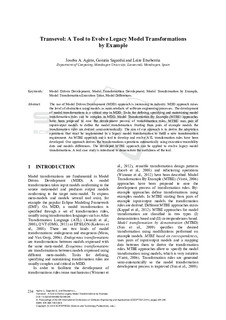Izenburua
Transevol - A Tool to Evolve Legacy Model Transformations by ExampleArgitalpen data
2014Bertsioa
Bertsio argitaratuaDokumentu-mota
Kongresu-ekarpenaKongresu-ekarpenaHizkuntza
IngelesaEskubideak
© 2014 SCITEPRESSSarbidea
Sarbide irekiaArgitaratzailearen bertsioa
http://doi.org/10.5220/0004999702340245Non argitaratua
Proceedings of the 9th International Conference on Software Engineering and Applications Volume 1: ICSOFT-EA. Vienna, 03-05 September. Pp. 234-245, 2014Argitaratzailea
SCITEPRESSGako-hitzak
Model Driven Development
Model Transformation Development
Model Transformation by Example
Model Transformation Execution Trace ... [+]
Model Transformation Development
Model Transformation by Example
Model Transformation Execution Trace ... [+]
Model Driven Development
Model Transformation Development
Model Transformation by Example
Model Transformation Execution Trace
Model Differences [-]
Model Transformation Development
Model Transformation by Example
Model Transformation Execution Trace
Model Differences [-]
Laburpena
The use of Model Driven Development (MDD) approach is increasing in industry. MDD approach raises the level of abstraction using models as main artefacts of software engineering processes. The develop ... [+]
The use of Model Driven Development (MDD) approach is increasing in industry. MDD approach raises the level of abstraction using models as main artefacts of software engineering processes. The development of model transformations is a critical step in MDD. Tasks for defining, specifying and maintaining model transformation rules can be complex in MDD. Model Transformation By Example (MTBE) approaches have been proposed to ease the development process of transformation rules. MTBE uses pair of input/output models to define the model transformation. Starting from pairs of example models the transformation rules are derived semi-automatically. The aim of our approach is to derive the adaptation operations that must be implemented in a legacy model transformation to fulfil a new transformation requirement. An MTBE approach and a tool to develop and evolve ATL transformation rules have been developed. Our approach derives the transformations operations automatically using execution traceability data and models differences. The developed MTBE approach can be applied to evolve legacy model transformations. A real case study is introduced to demonstrate the usefulness of the tool. [-]
Bildumak
Item honek honako baimen-fitxategi hauek dauzka asoziatuta:
Bestelakorik adierazi ezean, itemaren baimena horrela deskribatzen da: Attribution-NonCommercial-NoDerivatives 4.0 International
Related items
Showing items related by title, author, creator and subject.
-
Model Query Translator. A Model-level Query Approach for Large-scale Models
Sagardui, Goiuria (SCITEPRESS, 2015)Persisting and querying models larger than a few tens of megabytes using XMI introduces a significant time and memory footprint overhead to MDD workflows. In this paper, we present an approach that attempts to address this ... -
Parametric Surface-Based Modelling: A Review of Modelling Strategies and Identification of Future Research
Aranburu, Aritz; Justel Lozano, Daniel; Angulo Lizarraga, Iván (CAD Solutions LLC, 2020) -
Mondragon Unibertsitateak 12th CIRP Conference on Modelling of Machining Operations (12. CIRP Konferentzia Mekanizazio Prozesuen Modelatzeari buruzkoa) arrakastatsua antolatu du
Mondragon Unibertsitatea (Mondragon Unibertsitatea, 2009-05-13)






















